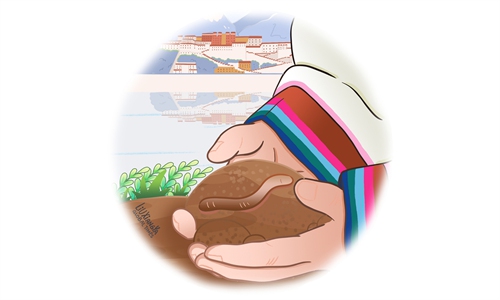ARTS / CULTURE & LEISURE
New gen of Tibetan music natural, free

Illustration: Liu Xiangya/Global Times
Speaking is singing, walking is dancing - that's the Tibetan way.Tibetan people have long been renowned for their exceptional musical gifts, and they take immense pride in this. When a young Tibetan faces strangers, it's no surprise that, like their peers, they might initially be shy and reserved. However, all of this happens before the music kicks in. Music is the cultural DNA of the Tibetan people. While for others, singing and dancing may be talents requiring cultivation and training, for Tibetan children growing up, music is more a way of understanding the world. Melody and rhythm, much like language and words, are tools for Tibetans to express themselves.
In his 17th year, high school student Dawa Sangye decided to embark on his own musical journey, following in the footsteps of his ancestors.
With a long and storied history, the Tibetan ethnic group harbors an incredibly rich tapestry of folk music and enchanting traditional dances.
"Song begets dance, dance begets song" represents a distinctive form of folk art, serving as a unique expression of self-entertainment. Whether in moments of respite from labor, during festivals and gatherings, or after a bountiful harvest, wherever there's a small piece of open space - be it on grassy knolls, in gardens, or in wheat fields - one can witness people of all ages singing and dancing together in Xizang.
This serves as an outlet for expressing their emotions toward nature, their aspirations for a beautiful life and their pursuits of love. It truly is a fitting description of a "sea of songs" and a "world of dance" in Tibetan culture.
Like most teenage creators, his debut piece was a rap song titled "One Love," not a love song per se, but a heartfelt, simple, and fresh narrative of emotions from a 17-year-old Tibetan boy. The song tells a story of leaving his hometown, heading to a city for education, and how he and the people around him helped each other.
"Even though I rank last in academic performance, I'm also a popular figure in the school. In our school, neither students nor teachers focus solely on your academic achievements; they care about your overall development."
The lyrics go, "In that harsh winter, there were 37 moments of understanding, all arising from the warmth of protection." Here, the 37 moments refer to the 37 kids in his class supporting each other and sharing the joy of triumph at school with the help of their teachers.
In Tibetan culture, there's a Buddhist concept: "All sentient beings are one." Dawa Sangye instinctively sees each of his classmates as a collective whole. The experiences and encounters of each individual are interconnected. Hence, the song is named "One Love." This way of thinking and narrative style is very Tibetan, and at the same time, it perfectly aligns with the mind-set of teenagers.
The new generation of Tibetan musicians, however, when engaging in original artistic narratives, have explored the music beyond their predecessors. They no longer persist in just using overtly distinctive elements to emphasize their ethnic identity, such as reciting a Tibetan Buddhist mantra, showcasing traditional melodies, or donning highly characteristic traditional clothing. These elements are too easily remembered and this creative path has a noticeable drawback; it tends to make the works become homogeneous.
The story of Dawa Sangye is representative and quite universal in today's music scene in Xizang. Musicians like Dawa Sangye, influenced by favorable circumstances, are independently choosing a more powerful, effective, and sustainable approach to their craft. This, in turn, is contributing to the establishment of a new musical ecosystem. They are no longer content with merely elevating the "distinctiveness" of their local music. Instead, they take a microscopic perspective, using individual, unique, emotional experiences, life attitudes and growth journeys as the starting point for their creations. In doing so, they are reinterpreting ancient Tibetan characteristics in a fresh light.
"One Love," the song that Dawa Sangye created, was a result of countless nights spent on his phone, playing the instrumental on loop, writing, rewriting, and refining throughout an entire semester. "I wanted to use this song to tell everyone that no one is alone, and I also want to take this opportunity to thank my alma mater," Dawa Sangye expressed.
After the song was released, it quickly resonated strongly with his Tibetan peers and began spreading to a broader audience. In the circles of young people, Dawa Sangye has become a well-known young musician.
Beyond being a means of entertainment or an art form, music is inevitably a medium for individual emotions and expressions. It is on this foundation that, while inheriting tradition, works can emerge that vividly reflect the spirit of a grand era. This is the starting point and destination of all art.
Today, the tunes from Xizang unfold with an increasingly natural, ever freer, and remarkably easy cadence, mirroring the very land that birthed them.
The author is a lecturer at Hunan University and holds a PhD from Renmin University of China. life@globaltimes.com.cn


